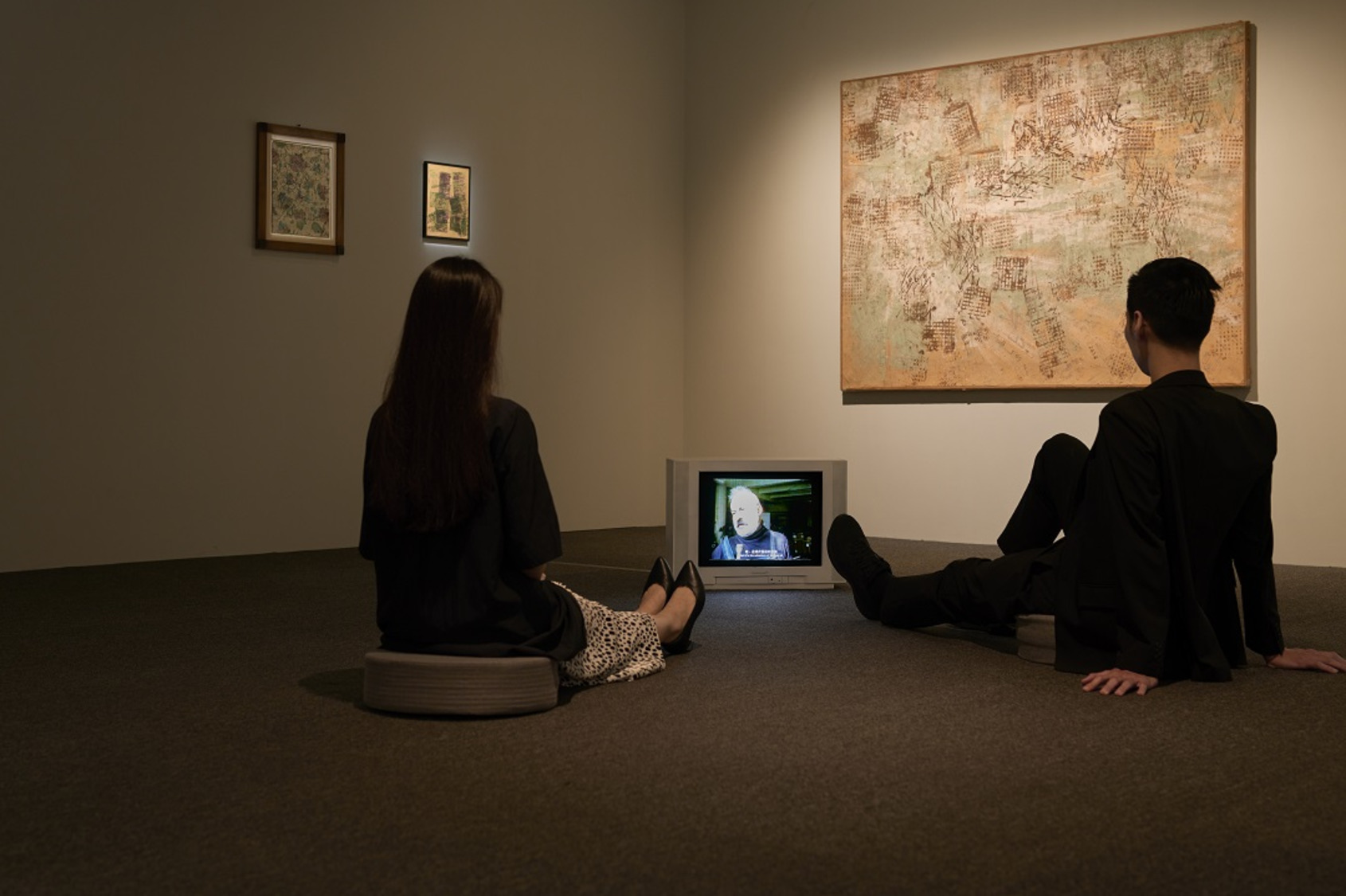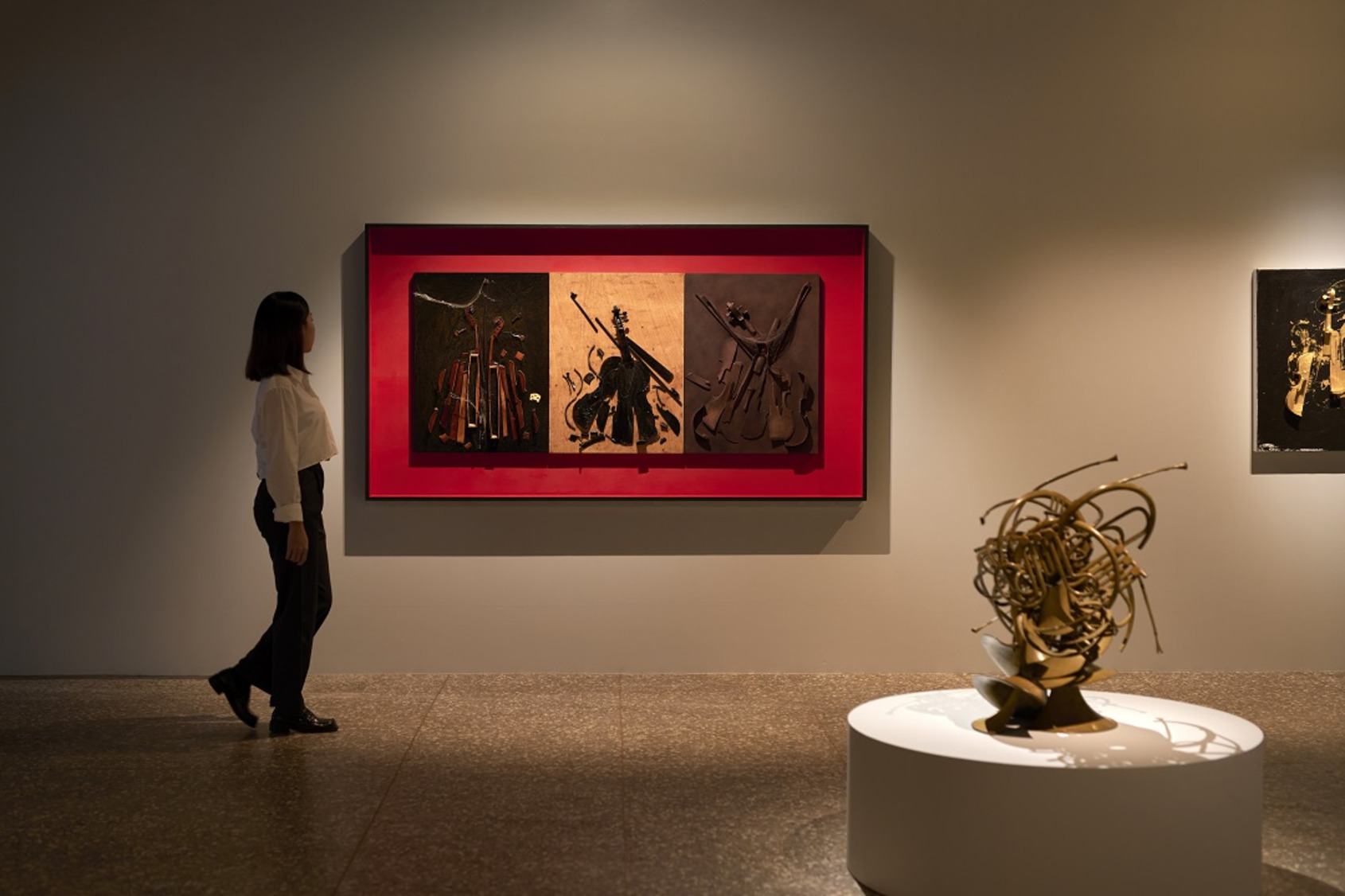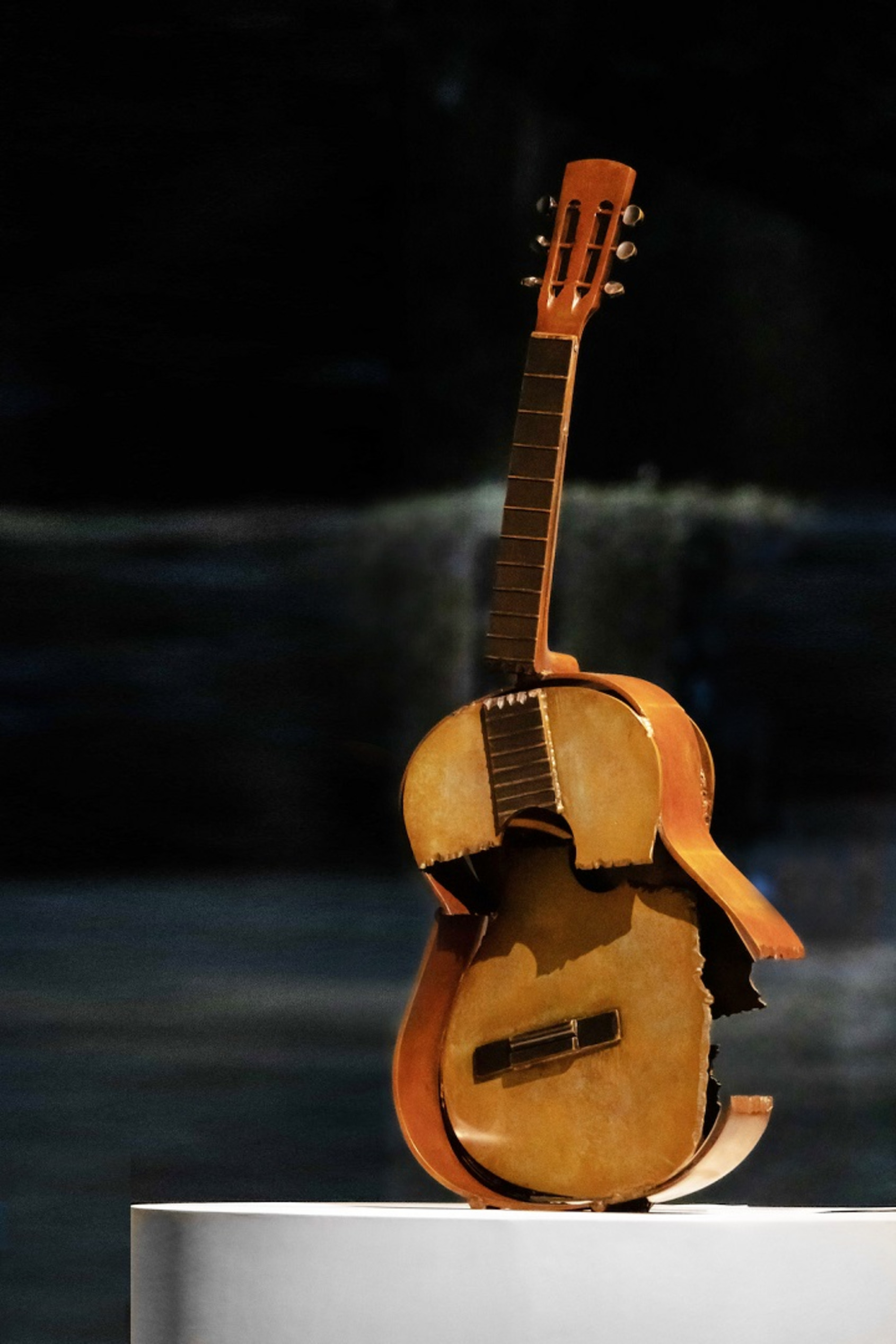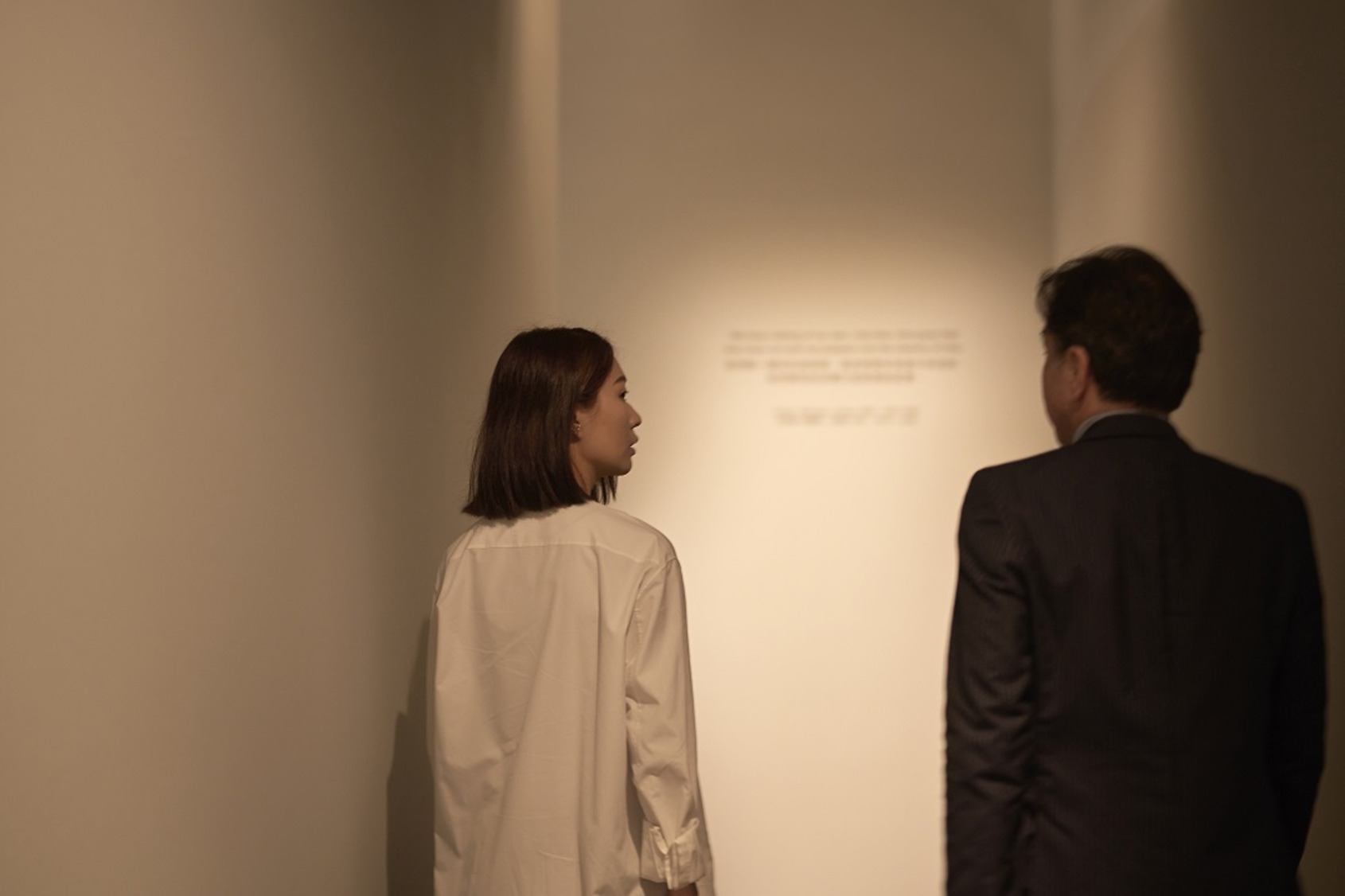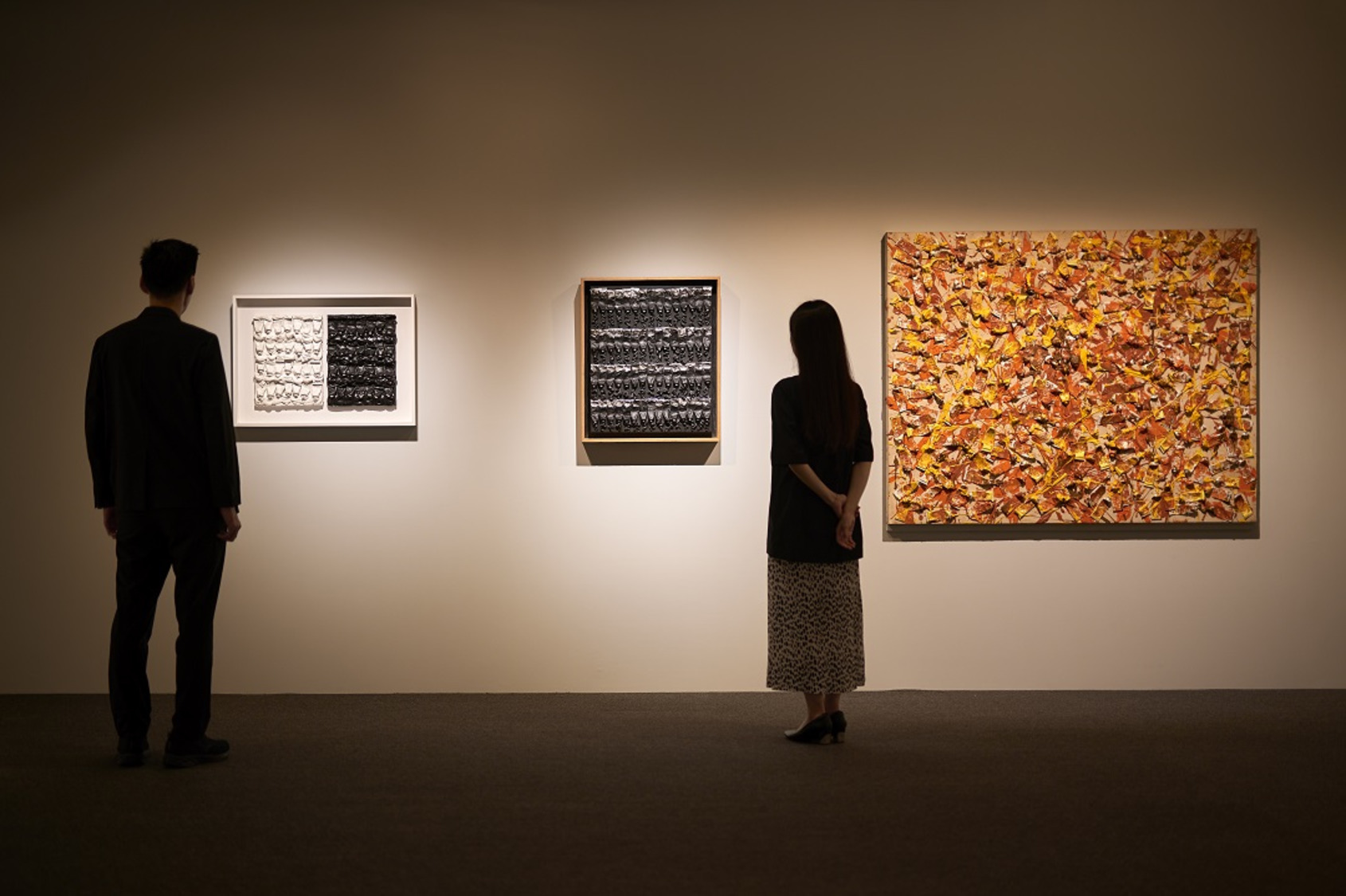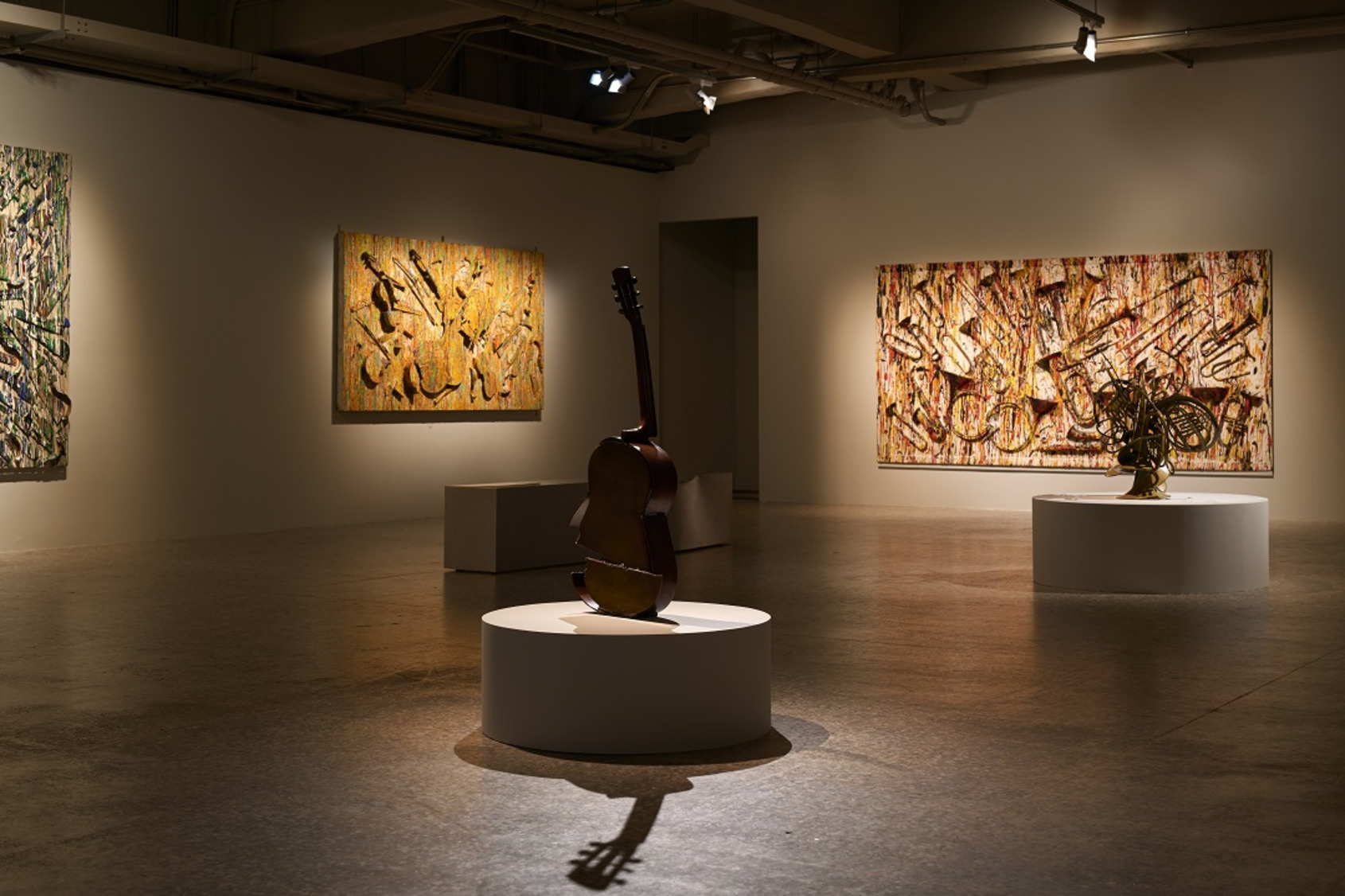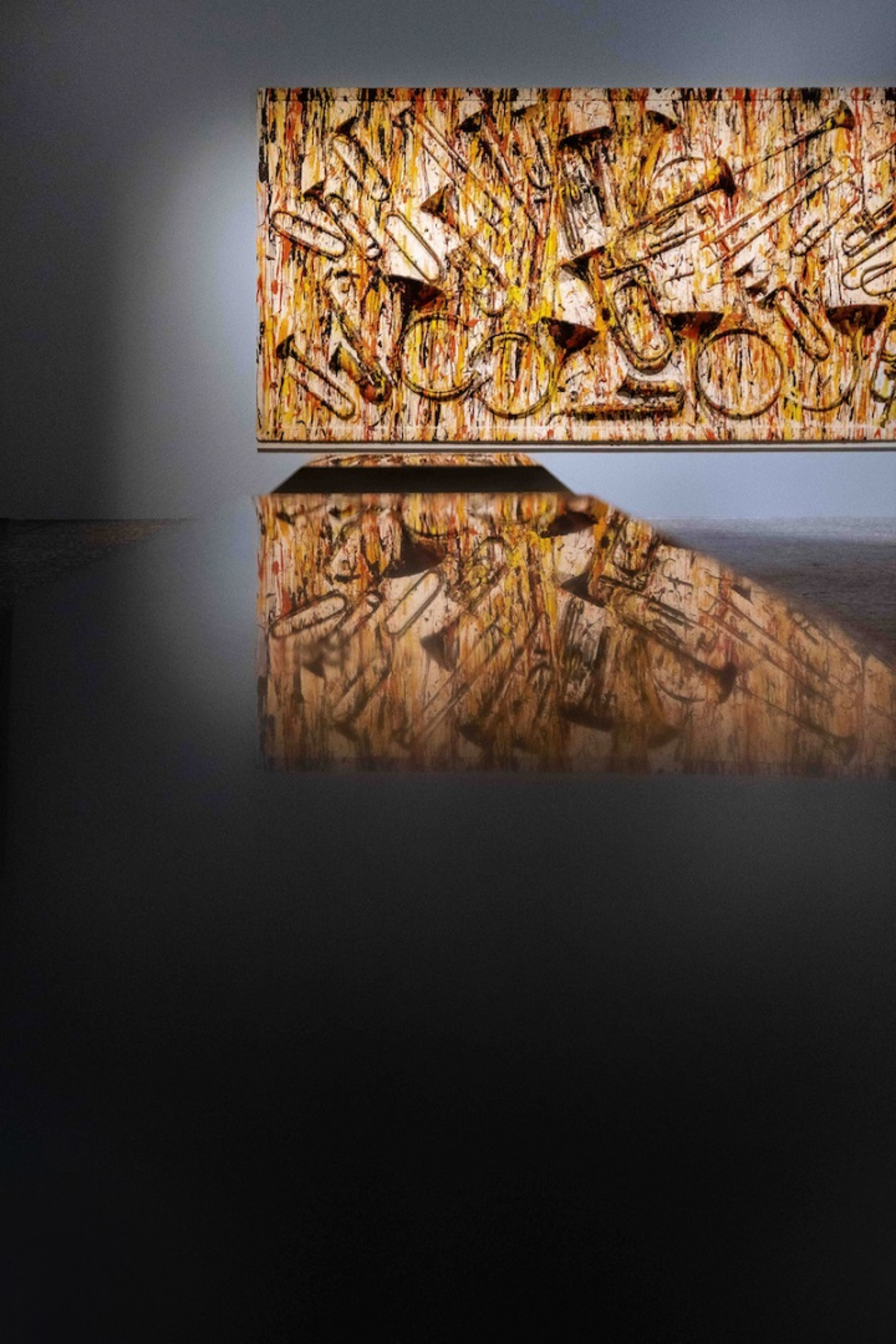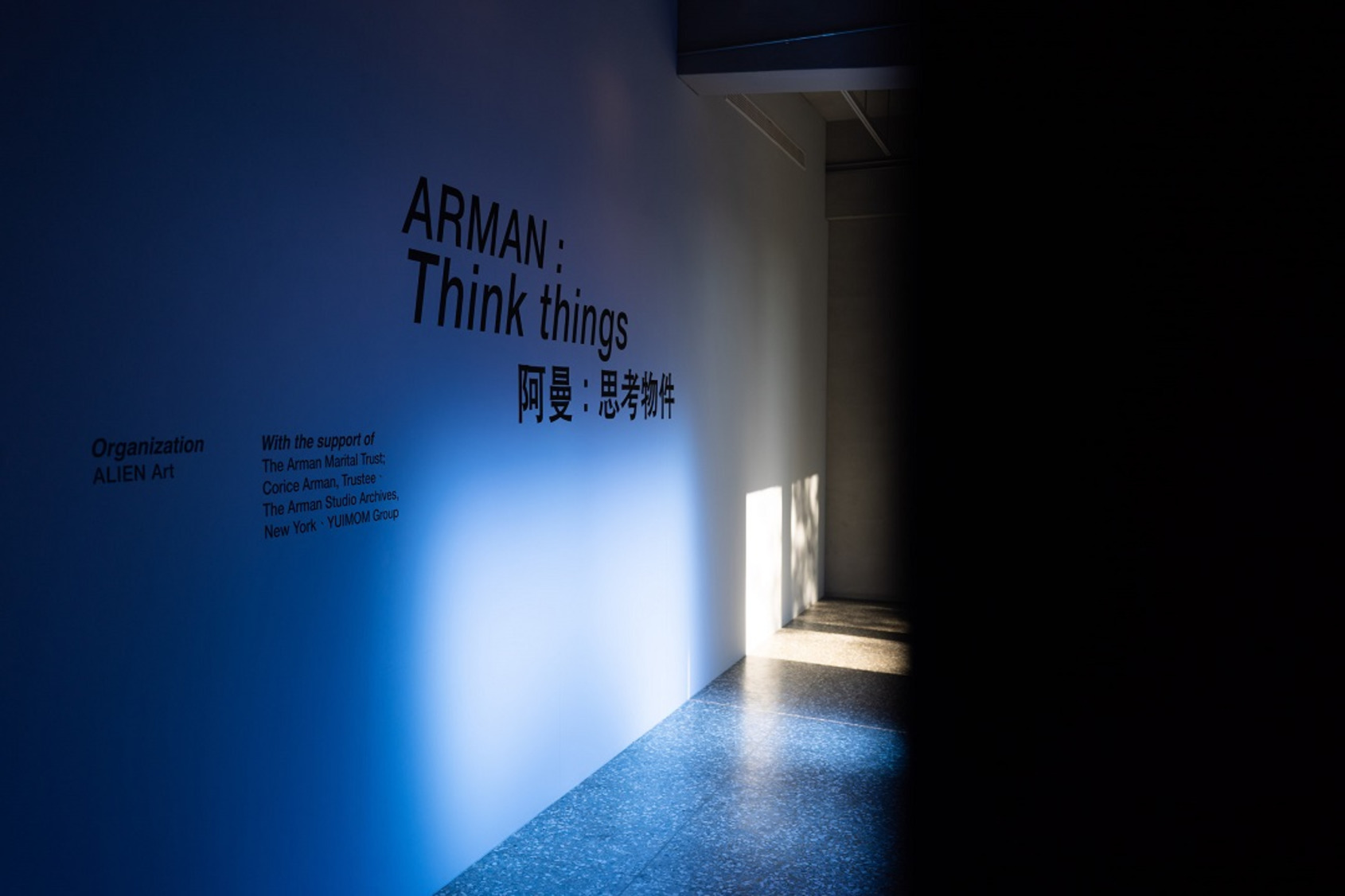TEXT:Jérôme Neutres
“I like to show the phases of something that we don't know ” — Arman
“ To change the state of an object is to change myself ”— Arman
The exhibition Arman: Think things aims to show the construction process by Arman of one of the most singular languages of art in the XXth Century through a special selection of some iconic works of the legendary artist founder of the New Realism movement. Our goal is to lighten the development of the style of Arman, the way he built his identity of artist. Arman invented a new way of expressing art. Though the artist first experimented his new technics on the same surface of the traditional canvas, he shifted early to 3D paintings, looking like sculptures, to move to proper sculptures. Our exhibition selection focuses on the first part of Arman’s successful career, a time when he was inventing this art grammar of him which will make him write a new chapter of art history.
Born in Nice in 1928, Arman started his art career in France in the 1950’s, along with his friend and partner in art Yves Klein. In October 1960, Arman visited in New York the exhibition “The art of assemblage” at MoMa, which showed the reorganization of things since cubism. New York had become after World War II the new center of the artworld, and Arman matched perfectly with the avant-garde ambiance of the roaring New York of the creative Sixties. Arman moved to New York in 1961 and will stay to the USA until he passed away in 2005. He became friend with Andy Warhol, and all the legendary Pop artists of that time. Center of the hyper-consumption society and of the materialistic ideology which devotes a cult to the manufactured object, America undoubtedly influenced the development of Arman’s language dedicated to the analysis of our relationship to “the things”.
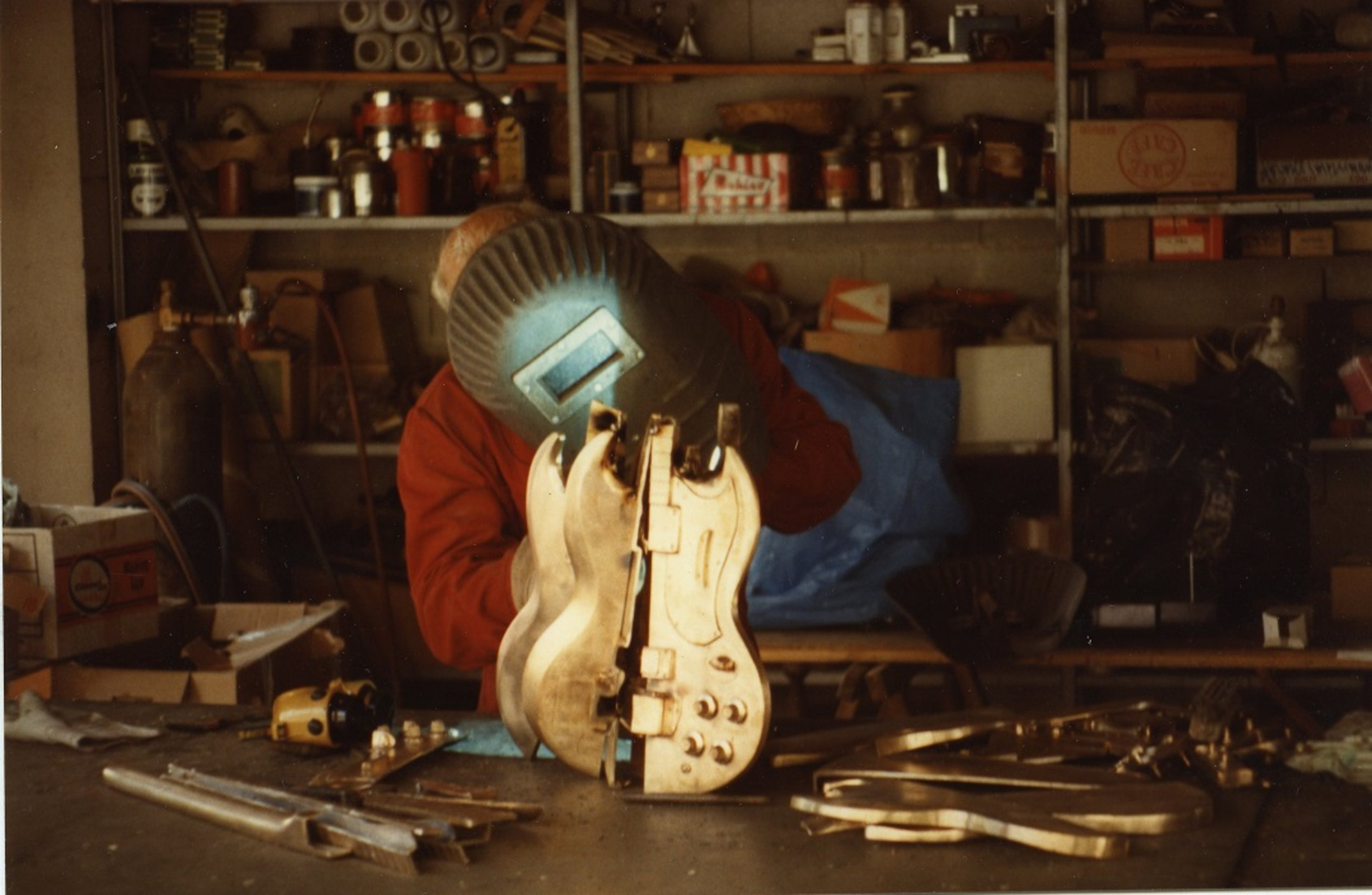 Arman working, Arman Vence Studio, 1985
Arman working, Arman Vence Studio, 1985
Courtesy of the artist.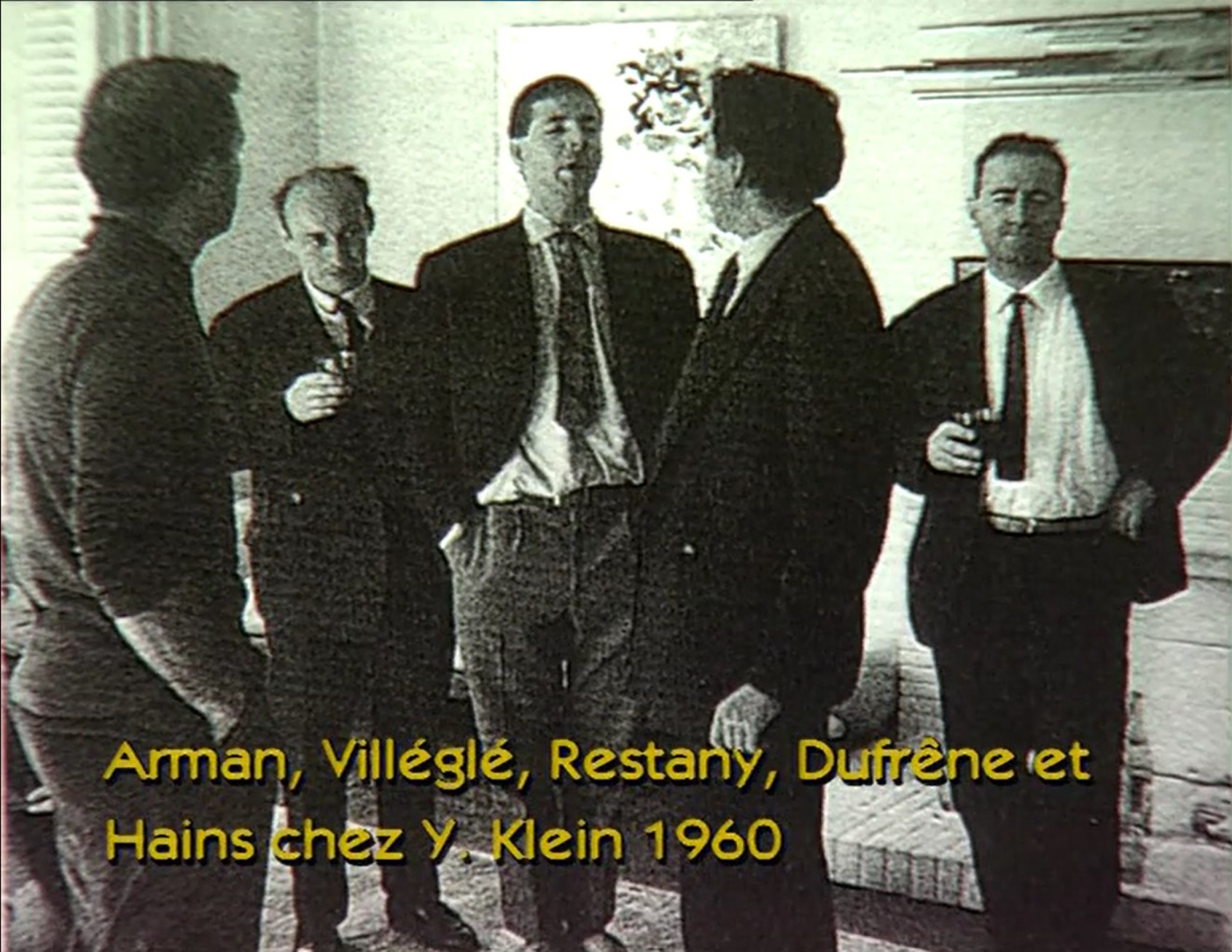 Arman, JacquesVilleglé, Pierre Restany, Francois Dufrene, Yves Klein, 1960
Arman, JacquesVilleglé, Pierre Restany, Francois Dufrene, Yves Klein, 1960
Courtesy of the artist.Arman’s story however starts in France, and our exhibition as well, where Arman initiates his quest of a new visual expression. Three works of the very early series of the “Cachets” (Rubber Stamps) are presented in the show: Cachet 54 (1954), Mauve administrative (1957), Priorité A (1957). Dated from the 1950’s, those rare works testify of the early and fundamental experiment by Arman of the “accumulation” concept as an art practice and a philosophy - even before using material objects in his creation. The “Cachets” are based on the original use of rubber stamps to multiply prints on a surface, generating original calligraphies. Transforming in choreographies of signs some daily stamps, those works highlight Arman’s main research: to re-think the things of life. A poet in the arts, Arman will work all along his career to reveal the hidden poetry behind the things. Those “Cachets” works, very singular and different in its technic, are however also the very first “accumulation” of Arman. Accumulation is certainly the other main concept of Arman’s art.
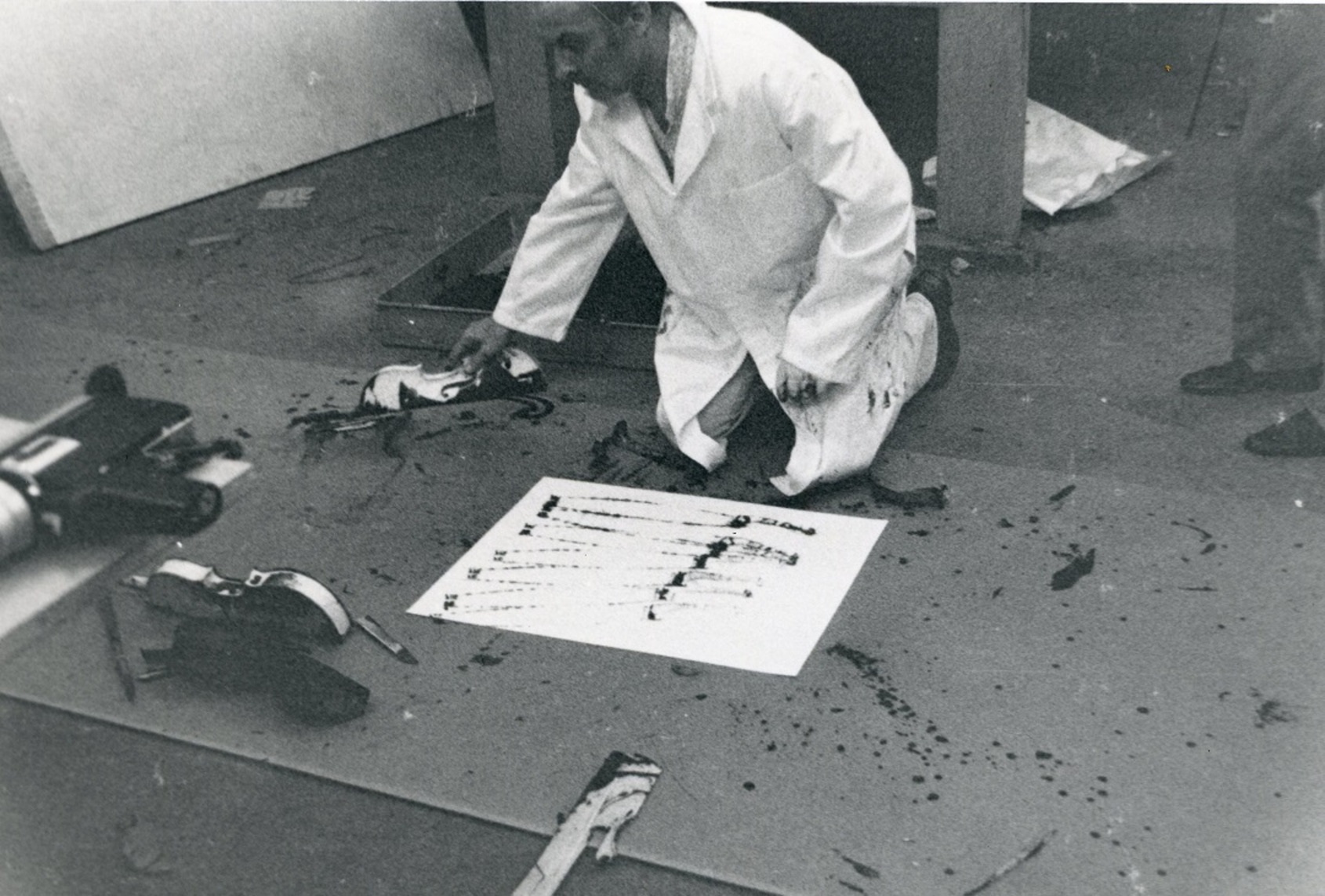 Arman working, 1969
Arman working, 1969
Courtesy of the artist.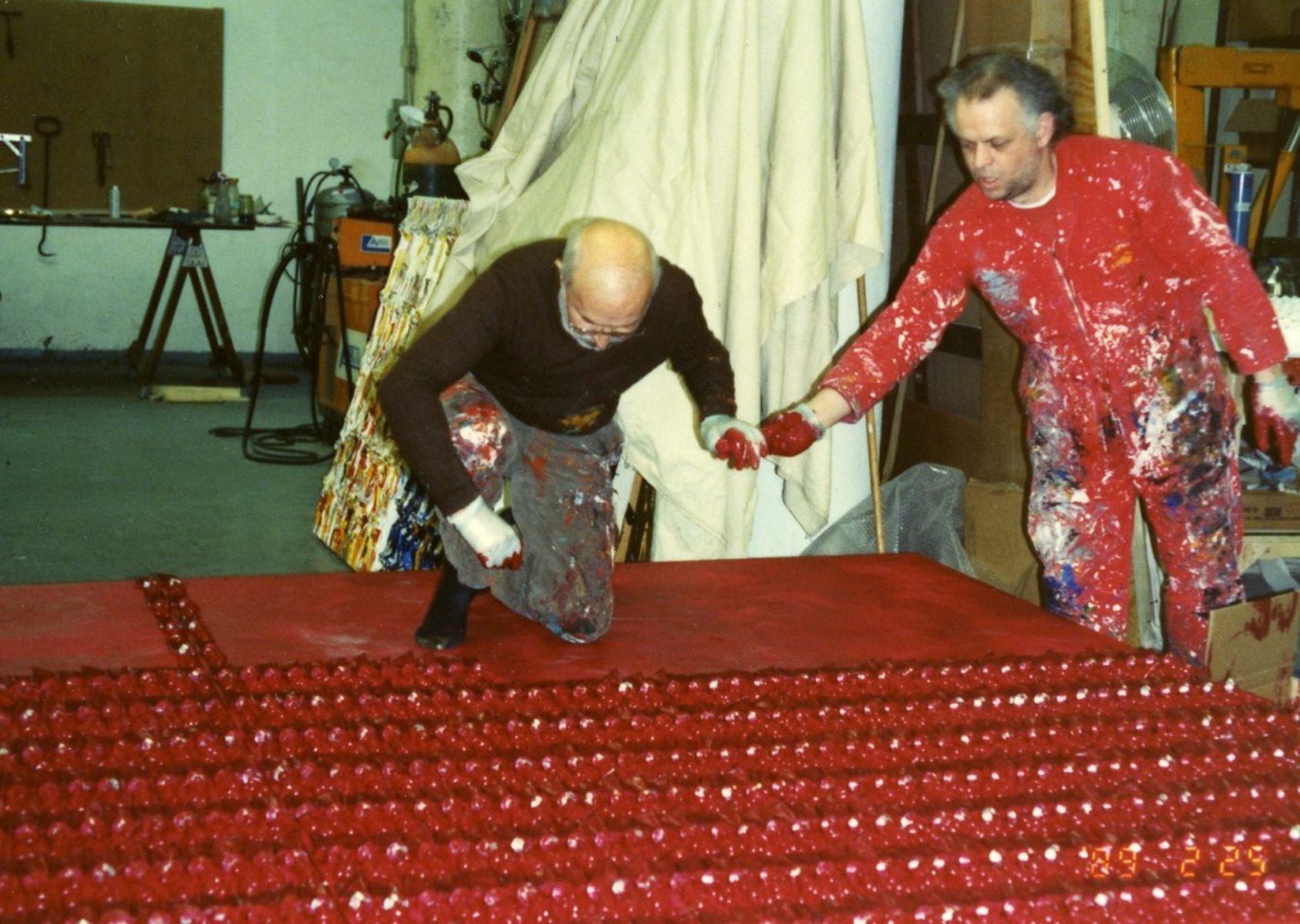 Arman working
Arman working
Courtesy of the artist.Accumulation is certainly the other main concept of Arman’s art. Arman was an accumulator of life. He collected everything he could in his lifetime: artworks (a fabulous art collection of Warhol, Klein, …), art objects, antiquities, art crafts, cars, houses, fine wines, friends… The accumulation concept in Arman’s art is also a way to question our modern way of life, based during decades on the accumulation of wealth and goods – the supermarket mass displays being the symbol of it. Logically the show presents some exceptional examples of “accumulations” of objects, painting tubes for instance - the kind of works which made Arman so famous and collected in the museums worldwide. Accumulating real objects of our life to create a new meaning for the objects through its serial presentation. The works become the flag of the hyper-consumer society we live in. Arman will use every object he found to create his accumulations: painting tubes, telephones, razors, forks, toys, coffee pots… Following the Rubber Stamps logic, Arman developed in the late 1950’s another series of imprints named the “Allures d’objets” (Objects Appearances) after a concept from the musical vocabulary. “When I unwound my objects soaked in ink, Arman explained, I printed their appearance. I used eggs, a shoe, ball bearings, bottles, springs… I took anything that could leave an interesting trace”. Our show counts with two major Objects Appearances: Procession (1964), and Saga (1975). In those two paintings, one can see how the traces of the objects look like a visual music score. In his art, Arman makes the objects singing the music of our material world.
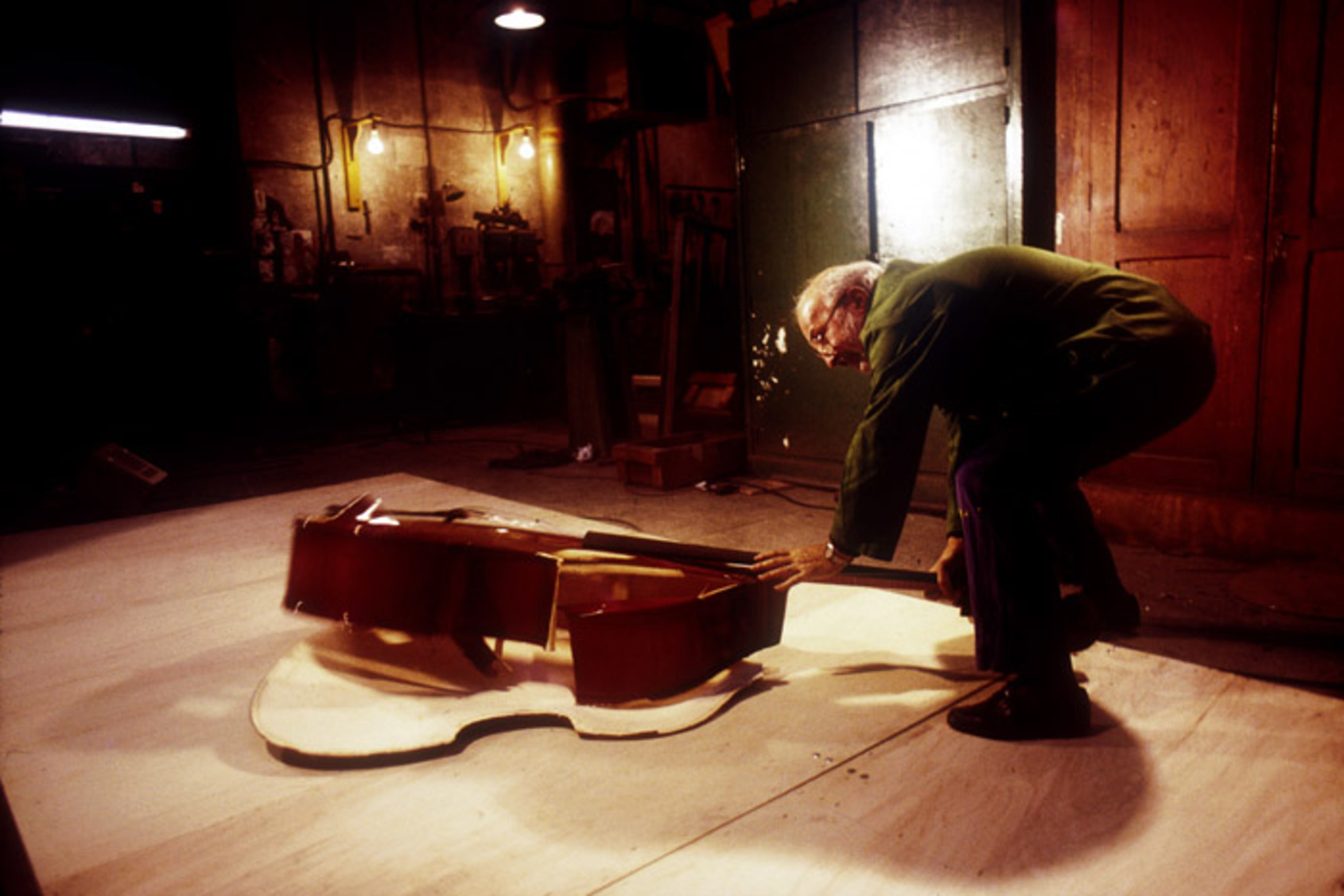 Arman working
Arman working
Courtesy of the artist.“Cutting a violin into thin slices is a scandalous act, Arman explains. The application of a technique or a method that could be applied to a sausage but which is not intended for a violin provokes a twisting of the thought, a change which, naturally, operates a psychological action”. Another technic invented by Arman is to meaningfully destroy some particular and precious object. Particularly the noble music instruments. Sliced saxo, smashed violin, broken bass… The show presents some works from the most important series of the “coleres” (rages) and “decoupes” (slicing) focusing on the fundamental thematic of music in Arman’s world. Arman often mentioned the dimension of an "archeology of the future" in his work. Arman transforms objects that have lost their functional usefulness into works of art. For this, he deliberately destroyed or burnt fine objects such as music instruments, questioning through this provocative gesture the problematic of destruction as a postulate of creation. Music is a fundamental and recurring theme throughout Arman’s work – the artist was a passionate music lover. Music instruments are cut, burnt, split by Arman, as in a demonstration of martial art. There is another music that comes out of these instruments: the music of the art of Arman. Our exhibition presents several works around this major thematic, including two major sculptures. Pour ma Jolie (“To my Lovely”) is an original cast in bronze - one of the first bronzes by Arman, which started this technique in the late 1970’s. The work represents a broken guitar which become the symbol of a love separation – the guitar being itself a symbol of the seduction. It is also a reference to a famous American movie. Arman is proposing in his works a redefinition of the music instrument - the artist substituting to reality a world that matches his imagination. Mumuyé is another example of slicing sculptures: here, sliced horns composed a new object which highlights the movement of the music in a sense – in the same logic, cubism “sliced” forms to give them movement. The second sculpture, Mumuyé (1985), is named after the name of a Nigerian Tribe, famous for music and for performances where they will smash clay pots. A collector of African tribal art, Arman was certainly very interested to find out there this unexpected encounter with his own style of creation.
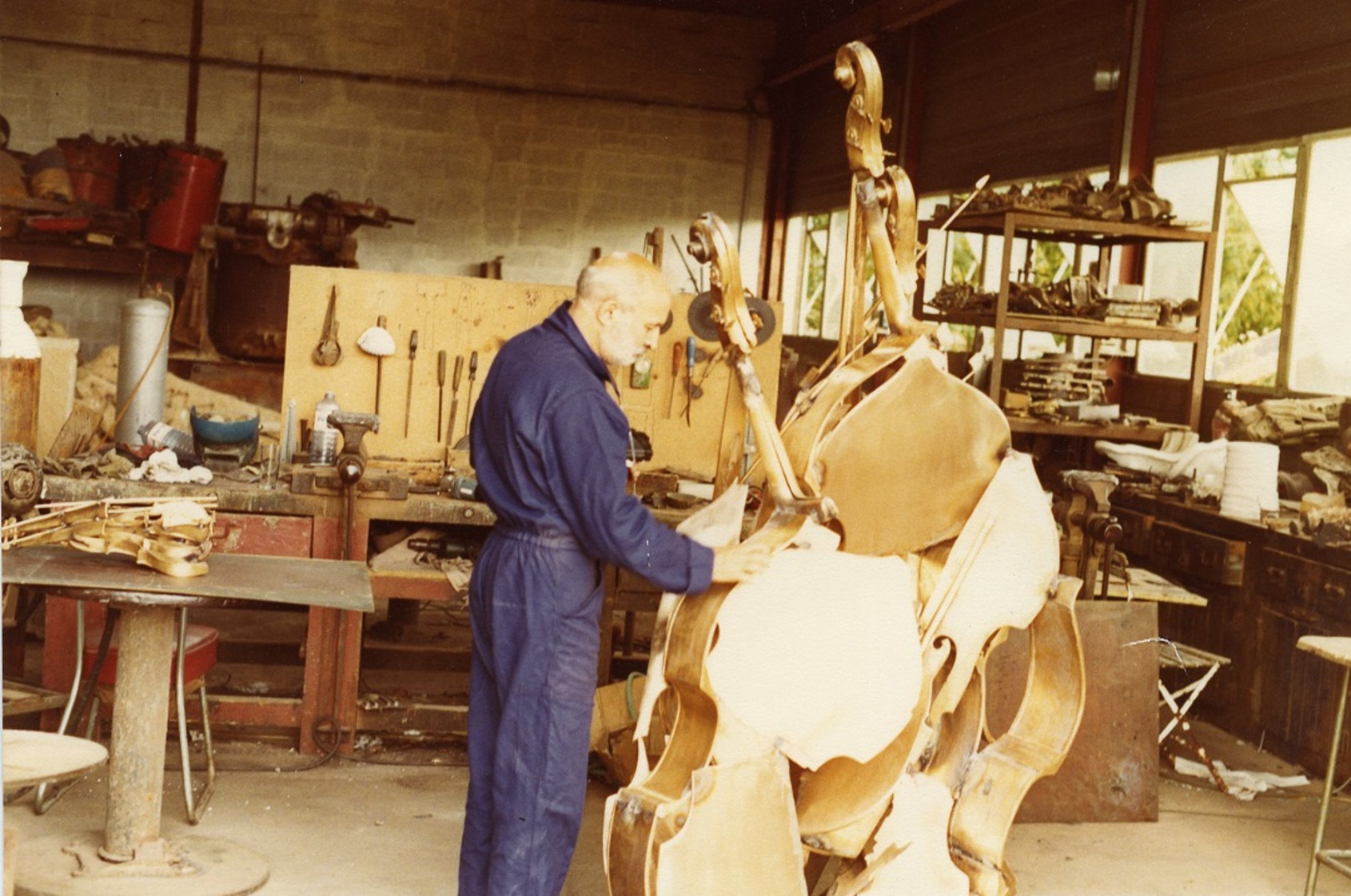 Arman working
Arman working
Courtesy of the artist.Every Arman exhibition could be subtitled “The Metamorphosis of Rejects”. Most of the works presented represent objects that no longer work. Violin, saxophon, cello, guitar… these precious instruments are here presented broken, burnt, destroyed by the artist himself, who took care to rid them of their functional properties, to transmute them into a work of art. Arman's art begins when the object breaks down. To give it a new use. And show how art offers another use of the world. A very meaningful proposition in today’s world, when the number one world debate is focusing on environmental issues and the necessity to recycle the used objects. Pioneer of recycling into art the things, Arman is more relevant today than ever. The artist eventually helps the objects break down. To (re)give meaning to what no longer has any: what was a broken violin before becoming a painting by Arman? Before to be the title of a leading series of his works, Rage for Arman is a sign of life. A positive energy, anger symbolizes life itself in the sense that it stages a gesture of destruction which is in fact a process of creation. Arman's art can also be seen as a challenge to death. Arman's first cuts were made in 1962, after the death of his art brother Yves Klein at the age of 32 - a life cut off in the full force of age and work. There is something about the death of the object in its cutting, or rather about the overcoming of the death of the object by a symbolic transmutation which assures it post-functional durability in the form of the work of art, stronger than death. Fix the decomposition on a board or immerse it in a resin like a body in formalin, to keep it intact as it is. “I would like to stop the speed, the explosion, the bursting, said Arman in 1963, patches of time, precious accidents where chance is always the same and again repeated”. The life of things is part of the things of life. This will be the fate of his art. Combustions, cuts, smashes, destruction... Arman breaks artistic codes as he breaks the original function of objects. “My father took me to an international exhibition where they showed engines and cameras cut in half, Arman explained. This revealing side of the interior fascinated me. For me, these are the guts of objects.” As other sculptors use clay or wood, Arman has made manufactured objects the raw material of his art. As the most noble objects, the music instruments play a strong symbolic role in this topic. Our exhibition displays a series of very special examples of Arman’s rages and slicing works. Colère sur bois (Rage on wood, 2001), is composed like a triptych after three violins sliced, broken and burnt on three wooden panels in a frame. This unique work is a rare example where Arman mixes in the same work three fundamental components of his style: the rage, the combustion, and the slicing. It is for that reason a true masterpiece of Arman’s art. Quatuor d’automne (1991) show Broken violins and cello with bow and acrylic paint on canvas with vibrant dripped colors such as yellow, orange, blue, green, ochre…The spectacular painting is truly a visual concert, forms and colors coming from various sources. Arman acts as an orchestra conductor playing all the instruments on his canvas. Fanfare sous le feu (1991) and Austerlitz sky (1990) are two other stunning examples of monumental canvases made after sliced and broken musical instruments with a symphony of acrylic paint colors. Those paintings in 3D become another kind of artwork, mix of sculpture and painting. Once more, Arman is pushing the borders of art, inventing a new form. Three works from 2002 (Untitled), show sliced musical instruments (two guitars, and a Saxo) with acrylic paint on canvas, in a more cubist way, reminding the interest of Arman for cubism – the art of movement.
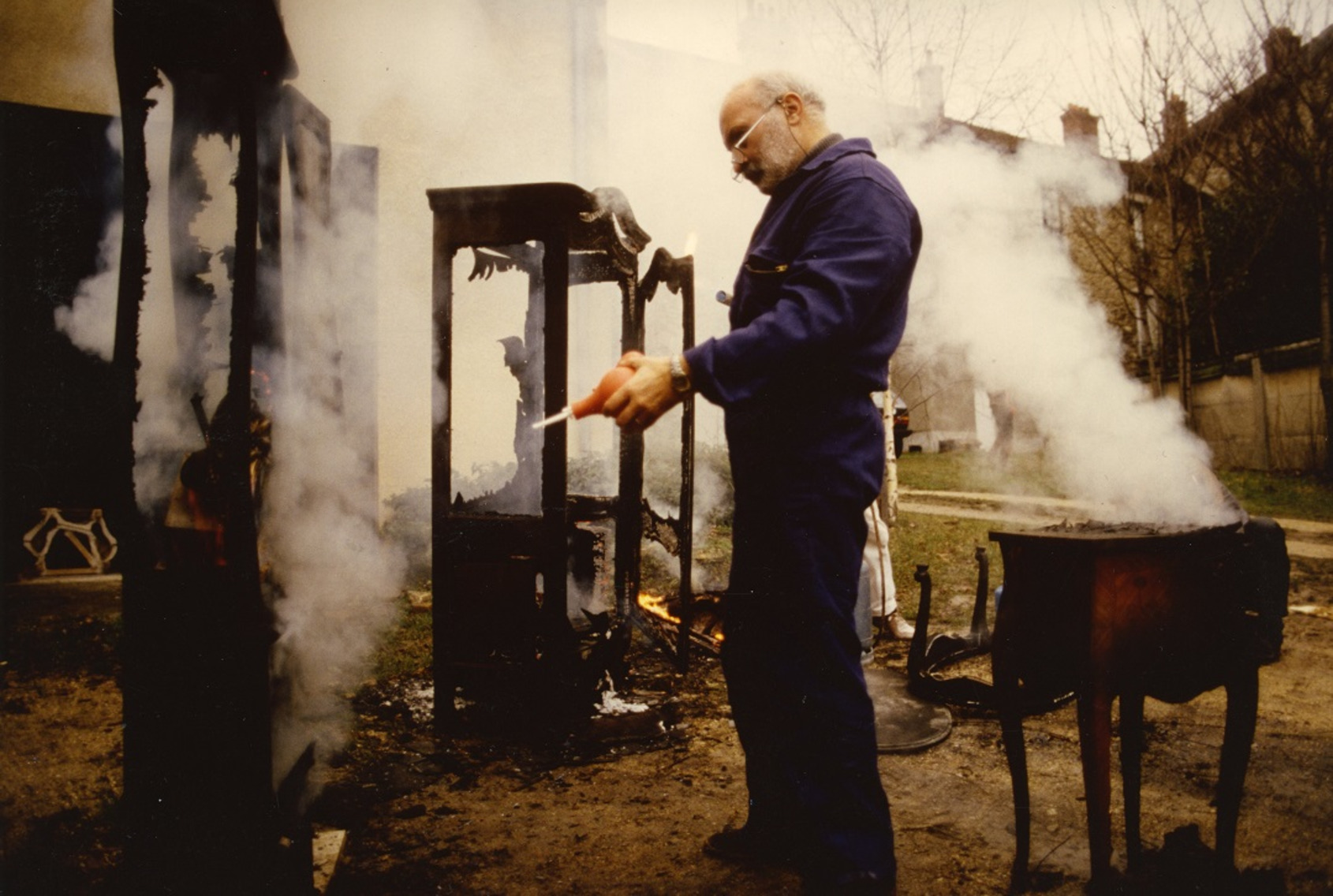 Arman working
Arman working
Courtesy of the artist.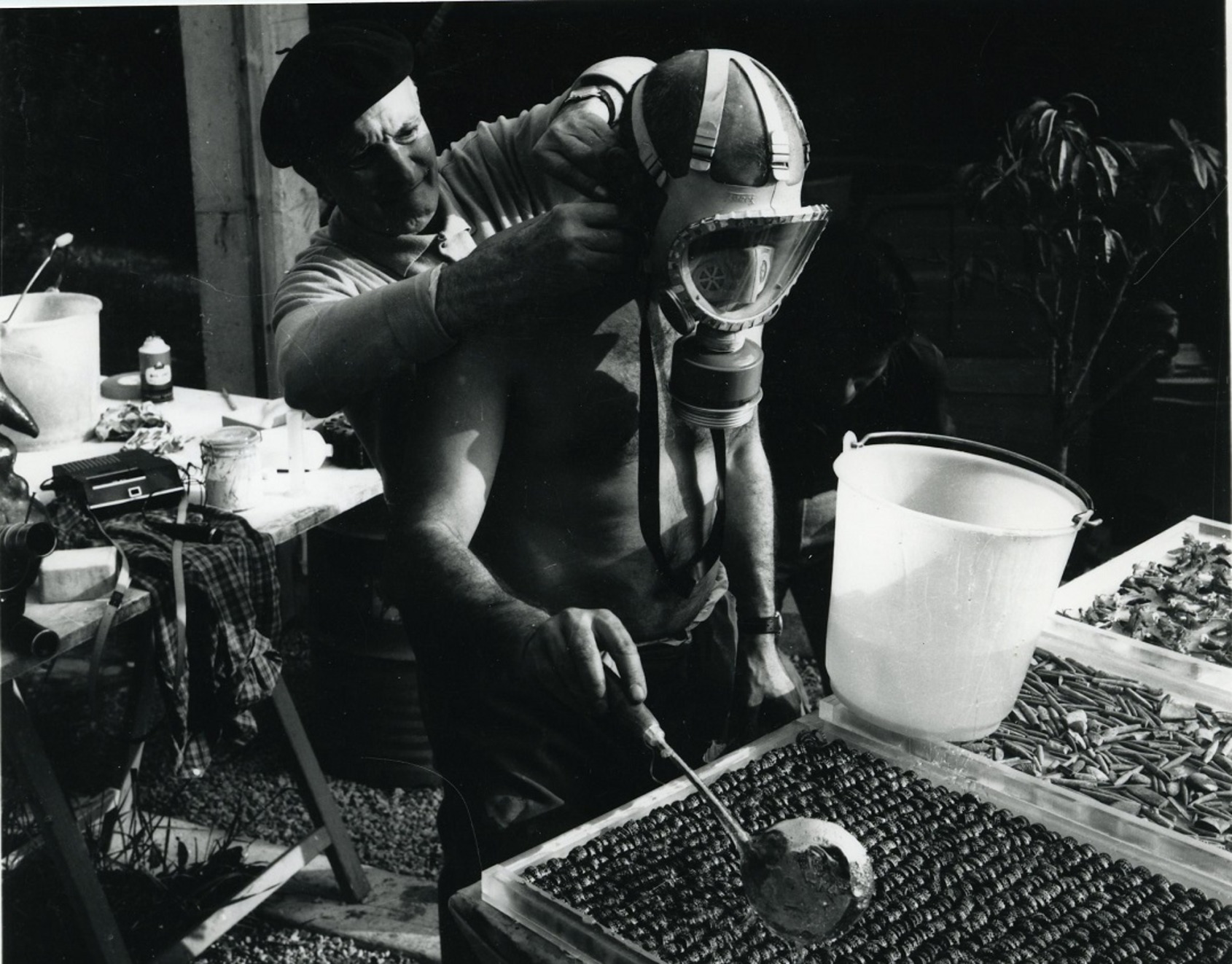 Arman working
Arman working
Courtesy of the artist.Arman is part of a history of art which is that of the reinvention of the mediums of creation in the industrial era. This special context of a Post-World War II new civilization of hyper consummation and industrial mass production have led artists to express new images for this new world. In the reign of the sacred industrial object, artists meaningfully developed their own critic of this new Consumers society. Arman’s work is part of this historical context, as well as Warhol’s art. Pop art encounters New Realism in the sense both movements focus on the hyper consumers new society. Warhol’s iconic painting showing a repetition of cans of Campbell's soup (Campbell’s Soup Cans, 1962), is clearly following the examples of Arman’s accumulations. Warhol uses also the object itself in a sense, or its advertising image, through simply reproducing it on the canvas as in a supermarket room. We could write a whole book about the dialogue between Pop Part and New Realism, and precisely the relationship between Arman and Warhol. In our show, we can see some works (the Rubber stamps for instance) which announce Warhol and his use of serigraphs and prints of daily objects. We also present a work by Arman, Bloody guns (1965), which could be seen as a pop artwork, by its colorful repetition of the motif of the gun on a canvas. We could associate this canvas with the accumulations of guns Warhol will paint in 1981 and 1982 (Gun). Arman and Warhol are two major artists, who happen to speak together and exchange through their works as well. Arman is developing other dialogues with his contemporaries he was a passionate collector of. Two works of our show, Monochrome 15, and Monochrome 20 (both works from 1988), accumulations of paint and tubes in acrylic white or black on canvases, are presenting a repetition of the object of the paint tube with the symmetry of Warhol’s accumulations, and the monochromatic colors of Robert Ryman’s monochromes (so famous works in the 1980’s in New York). Like his good friend and fellow Warhol, Arman wrote a fundamental chapter by opening new fields to the visual creation. There are artists – even brilliant ones – whose work closes on itself; and others that offer new possibilities for art, and inspiring new forms. Arman is one of the latter, a true Pygmalion during his life (his correspondence is full of letters of advice to young artists) and even more beyond, by the influence of his work, which benefited from an extraordinary international diffusion – Arman was shown around the world and his works can be seen in museums and private collections over the world. It would take an entire book to evoke the profound influence of Arman on contemporary artistic production, far and wide, from Damian Hirst’s pharmacies, to Subodh Gupta’s compositions of kitchen tools from India. Those two majors figures of contemporary art have elected the object as their focus, and the accumulation concept as a main thematic of their work. It is interesting to underline how Arman’s influence has been particularly important for Asian contemporary artists in the early stage. In China, both Chen Zhen and Ai Wei Wei, leading figures of contemporary art of the last part of XXth Century, have been inspired by Arman’s philosophy of the things. In the Biennale of Venice of 2013, Ai Wei Wei displayed an accumulation of 886 three legged wooden stools entitled Bang. This work was also clearly a tribute to Arman’s cascades of chairs, through the Chinese artist composed a fully deconstructed movement of chairs inspired by the expansive rhizomatic structure, while Arman would prefer a homogeneous movement inspired by the cinema in his displays. Interestingly, in the same Biennale of Venice, the Chinese artist Shu Yong presented also an accumulation of resin bricks (with phrases produced by translation). Those major contemporary artists are not copying Arman, but their work conserve the deep mark of Arman’s significant legacy to the contemporary creation.
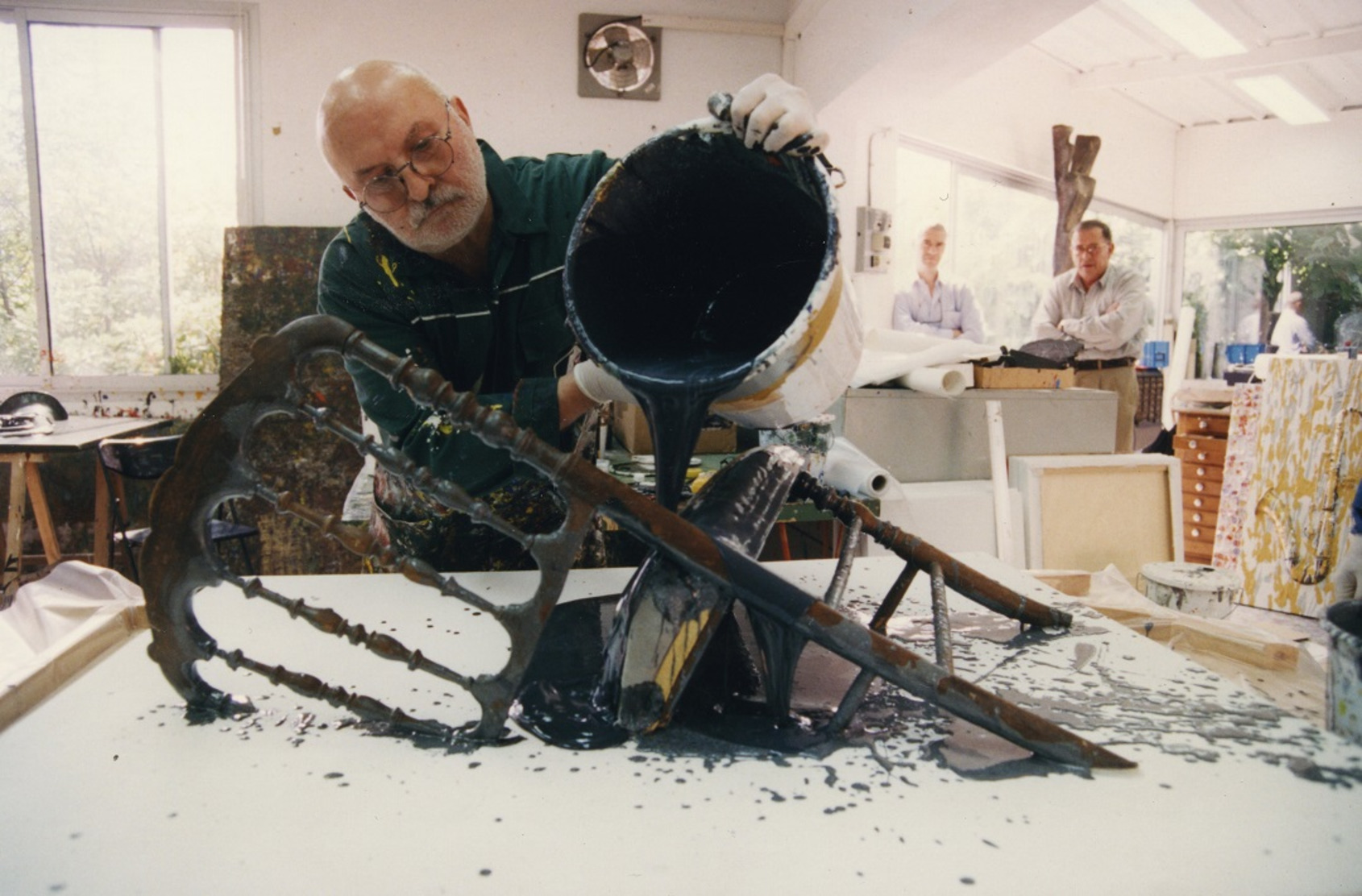 Arman working
Arman working
Courtesy of the artist.The exhibition “Arman early masterpieces: Think things” is a new chapter for my collaboration with ALIEN ART CENTRE. After being invited to the Hsiao Chin Art Talk at the Centre in 2019, I co-curated the Shozo Shimamoto survey in 2019-2020 with the Centre, aiming to participate in a contemporary rediscovery of those XXth Century Masters who have influenced so much today’s contemporary artists. I am convinced that some artists of the past, could be more relevant today than they were yesterday. The thematic developed by Arman around our hyper consumer relationship to the objects, finds out in today’s debates a strong and powerful echo. Arman, like Shimamoto, or Hsiao Chin, is also a true inventor of forms who reset the art with a new style and a new medium. Making things its palette, Arman created a new language, offering to a vast audience of art lovers from all over the world, new figures to express a new vision of the world. This show we present in Kaohsiung aims to reconnect museum visitors with Arman, who happened to be exhibited and collected in Taiwan during his lifetime and exhibited at the National Museum of Taipei. The works of our show are all coming from an exceptional loan cooperation with the Arman Estate based in New York. I thank deeply Corice Arman for the generosity of this collaboration, which allows the audience of Taiwan to rediscover Arman through museum quality works. To present a survey of Arman in Kaohsiung takes a very special dimension as Arman had all along his life a deep dialogue with Asia and its cultures. I work with Ms. Yaman Shao, with the deep trust built upon my observation to the relevance and the accuracy of the Centre’s artistic program, with every exhibition’s proposition is undoubtedly meaningful. Arman travelled to Taiwan and all Asia, fascinated by the history, the patrimony, and the arts he encountered in the region. Arman has been deeply inspired by Asian culture. He was among the very first Europeans – and probably the unique artist- to practice since his childhood the judo for instance (along with his best friend Yves Klein), at a professional level. He used to play “Go” game at an expert level as well, fascinated by this game. He spent his whole life collecting Chinese antics and Japanese antiquities – singularly the Japanese warriors’ armors. His collection of Asian antiquities has been exhibited in museums in France. Arman was living with those Asian works, as a permanent source of inspiration. When you entered in his living-room in New York, you were greeted by two Japanese warriors’ armors. In his imaginary world, Arman, expert in Asian martial arts, was a kind of Asian warrior. Arman became in NY very close to Japanese artists living at the same period in the American capital of the arts such as Yakoi Kusama, Arukawa, or Tadaaki kuwayama. Arman exhibited in many museums exhibitions in Japan and Asia in the 1980’s, the most iconic exhibition was presented at the Taipei National Museum in collaboration with the Galerie du Jeu de Paume in Paris. Arman also visited two times China where he exhibited and performed two famous “happenings” in 1988 in the Great Hall for a charity to save the Great Wall of China.
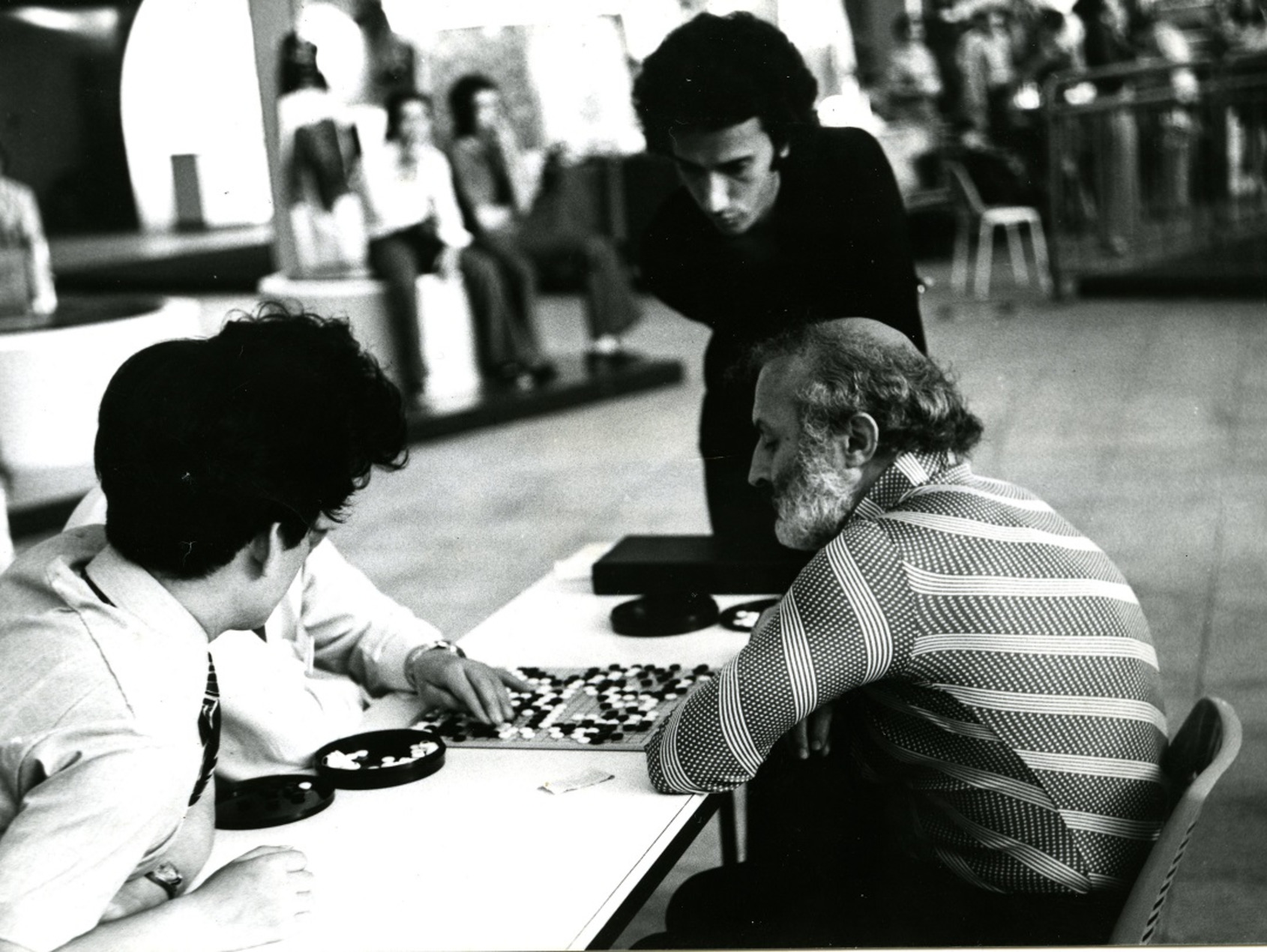 Arman used to play “Go” game at an expert level as well, fascinated by this game.
Arman used to play “Go” game at an expert level as well, fascinated by this game.
Courtesy of the artist.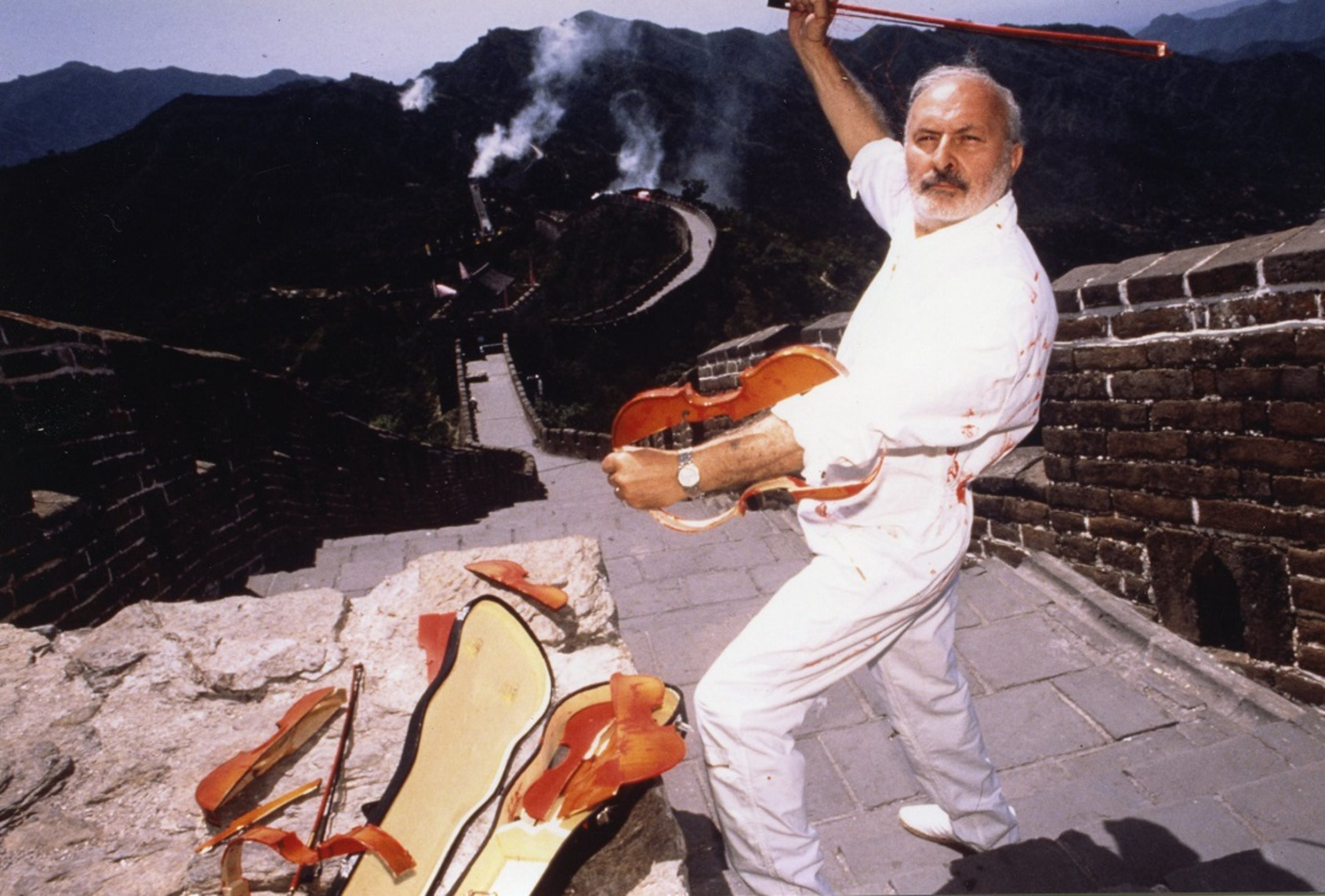 Arman visited two times China where he exhibited
Arman visited two times China where he exhibited
and performed two famous “happenings” in 1988 in the Great Hall
for a charity to save the Great Wall of China.
Courtesy of the artist.In contemporary art, Arman happened to be also a great admirer and follower of the Gutaï art actions, that ALIEN ART CENTRE showcased last year with a great success. Arman was fascinated by the energy and the physical process of creation of the Gutais, and quite recognized himself in their philosophy. Indeed the Rages (Colères) are directly coming from the Gutai actions, to transform the violence into a creative gesture. Indeed, Arman belongs to the same post World War II generation, like the Gutais founders. How to create a new world after the chaos is also an issue of the art of Arman, who started his very first works in the early 1950’s. Gutaï movement is characterized also by the ambition of its founders to establish from the beginning a dialogue with the western world, especially Paris – then still a leading cultural capital. Following his visit to Japan in 1957 the art French curator Michel Tapié made Gutai became well known in France, much before it was recognized in the USA, and even with more echo and reception than in Japan itself. In Japan, paradoxically, the Gutai movement was received with skepticism first by the academic circles and the art critics, especially after the Gutais got a recognition in Europe. Like it was for the Gutais, Art is a martial art for Arman as well. The Franco-American artist was a Judo expert and a Kung Fu instructor. This intimate dialogue between Arman’s early actions paintings and the Gutais was never really highlighted in an exhibition, and it is a gap in the art history that ALIEN ART CENTRE is filling through the presentation of the successive surveys of Shimamoto (2019) and Arman (2022). It is not a coincidence if the founder of the Shimamoto Association (Naples, Italy), Giuseppe Morra, is also a longtime collector of Arman. Arman has developed the topic of destructive creation in a very achieved and complex way, which has become a reference for many contemporary artists. Another artist I studied carefully through the years, Cai Guo Qiang, as founded his unique signature style of the gun powder painting after this topic of destructive creation. Cai Guo Qiang uses combustion of powder as the main energy of his paintings process. Arman’s illustration of the creative capacities of burning have been certainly an example for Cai Guo Qiang, whose whole work in another form of constructive rage. An art exhibition is interesting when it is the place of such artistic dialogues and encounters. I don’t forget however that an exhibition is first, basically the encounter between an artist and an audience. I am convinced that, following the context of the essay, the audience would be more confident in accessing the issues and meanings of the singular and fascinating poetry of Arman’s works. To re-think things (and life) through an artistic perspective.
ARMAN: Think Things
Period
2022.11.23 - 2023.07.02
Place
ALIEN Art Centre
Curatorship and Setting-up
Yaman Shao, Jérôme Neutres
Organization
ALIEN Art
With the support of
The Arman Marital Trust; Corice Arman, Trustee; The Arman Studio Archives, New York; YUIMOM Group












